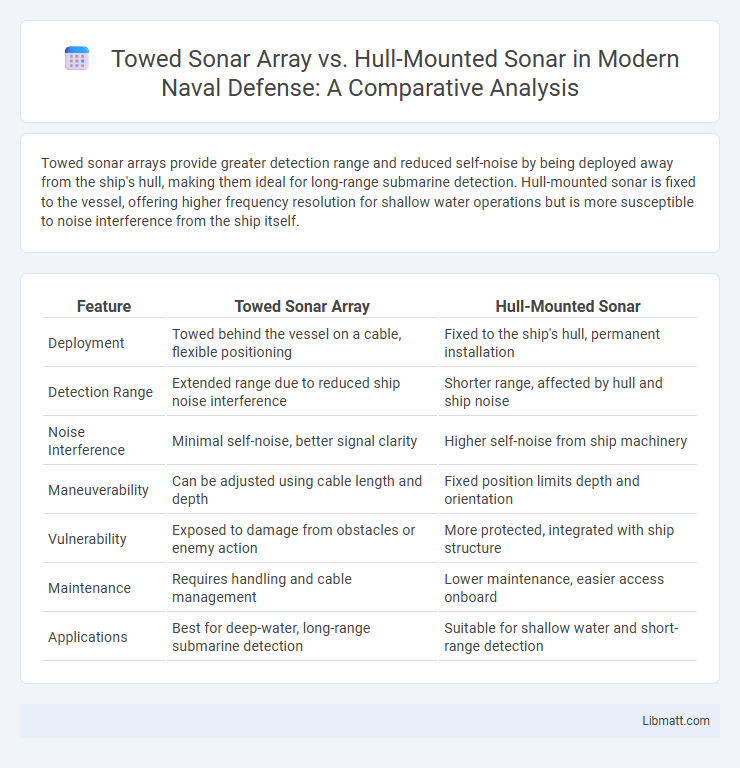Towed sonar arrays provide greater detection range and reduced self-noise by being deployed away from the ship's hull, making them ideal for long-range submarine detection. Hull-mounted sonar is fixed to the vessel, offering higher frequency resolution for shallow water operations but is more susceptible to noise interference from the ship itself.
Table of Comparison
| Feature | Towed Sonar Array | Hull-Mounted Sonar |
|---|---|---|
| Deployment | Towed behind the vessel on a cable, flexible positioning | Fixed to the ship's hull, permanent installation |
| Detection Range | Extended range due to reduced ship noise interference | Shorter range, affected by hull and ship noise |
| Noise Interference | Minimal self-noise, better signal clarity | Higher self-noise from ship machinery |
| Maneuverability | Can be adjusted using cable length and depth | Fixed position limits depth and orientation |
| Vulnerability | Exposed to damage from obstacles or enemy action | More protected, integrated with ship structure |
| Maintenance | Requires handling and cable management | Lower maintenance, easier access onboard |
| Applications | Best for deep-water, long-range submarine detection | Suitable for shallow water and short-range detection |
Introduction to Sonar Technologies
Towed sonar arrays offer enhanced detection capabilities by being deployed behind a vessel, reducing self-noise interference and providing superior low-frequency performance for submarine tracking. Hull-mounted sonar systems are fixed directly to the ship's hull, delivering consistent coverage and ease of use but often suffer from higher ambient noise levels. Your choice depends on mission requirements, balancing the towed array's long-range sensitivity against the hull-mounted system's operational simplicity.
Fundamentals of Towed Sonar Arrays
Towed sonar arrays operate by trailing a long, flexible array of hydrophones behind a vessel, which minimizes self-noise and allows detection of quieter or more distant underwater targets compared to hull-mounted sonar. The separation from the ship's hull reduces interference from machinery vibrations and flow noise, enhancing sensitivity and accuracy in submarine and mine detection. The fundamental design emphasizes flexibility and length, enabling broad frequency range reception and improved azimuth resolution in complex acoustic environments.
Overview of Hull-Mounted Sonar Systems
Hull-mounted sonar systems are fixed directly onto the ship's hull, offering continuous active and passive sonar capabilities essential for underwater detection and navigation. These systems provide high-frequency acoustic signals for detailed imaging of nearby objects but have limitations in range due to hull noise interference. Hull-mounted sonar excels in shallow waters and is integral to anti-submarine warfare, mine detection, and navigation safety.
Detection Range and Sensitivity Comparison
Towed sonar arrays offer enhanced detection range and sensitivity compared to hull-mounted sonar due to their ability to operate at greater depths and reduced self-noise interference. Hull-mounted sonar systems are limited by ship noise and shallow deployment, which can degrade sensitivity and reduce effective detection range. Towed arrays excel in detecting quiet and distant targets by utilizing longer apertures and improved signal-to-noise ratios in deep water environments.
Noise Interference and Signal Clarity
Towed sonar arrays reduce noise interference by being deployed away from the ship's hull, minimizing the impact of self-noise generated by the vessel, thus enhancing signal clarity. Hull-mounted sonars often suffer from noise pollution caused by the ship's machinery and flow noise around the hull, which can degrade sonar performance. The spatial separation of towed arrays allows for better detection of faint underwater signals, improving accuracy and target resolution compared to hull-mounted systems.
Deployment and Operational Flexibility
Towed sonar arrays offer enhanced deployment flexibility by extending behind a vessel, reducing self-noise and allowing detection of quieter targets at greater distances. Hull-mounted sonar is permanently fixed to the ship's hull, providing immediate operational readiness but limited by the vessel's noise and depth constraints. Your choice depends on mission requirements, as towed arrays excel in deep-water surveillance while hull-mounted sonar suits rapid response and shallow water operations.
Maintenance and Durability Considerations
Towed sonar arrays require regular maintenance due to exposure to harsh underwater environments and mechanical stresses from deployment and retrieval, demanding specialized handling and repair skills. Hull-mounted sonar systems benefit from easier access for maintenance onboard, but their fixed position makes them susceptible to damage from collisions and corrosion on the ship's hull. Your choice should consider the trade-off between the towed array's higher operational complexity and the hull-mounted system's vulnerability to physical wear and tear.
Applications in Modern Naval Warfare
Towed sonar arrays provide enhanced detection capabilities for submarines and underwater threats due to their ability to operate at variable depths, minimizing self-noise from the vessel. Hull-mounted sonars offer continuous, broad-area surveillance but may struggle with limited detection ranges and higher noise interference from the ship. Your choice in modern naval warfare depends on mission requirements, balancing stealth and situational awareness to optimize anti-submarine warfare effectiveness.
Cost and Logistical Implications
Towed sonar arrays generally involve higher initial costs and increased logistical complexity due to deployment, retrieval, and maintenance processes compared to hull-mounted sonar systems. Hull-mounted sonar offers lower installation and operational expenses with easier access for repairs and upgrades, making it more cost-effective for regular naval operations. Your choice between the two will significantly impact budget allocation and mission planning efficiency.
Future Trends in Sonar Technology
Towed sonar arrays offer enhanced flexibility and reduced self-noise compared to hull-mounted sonar, enabling improved detection capabilities in complex underwater environments. Future trends indicate increased integration of AI-driven signal processing and modular designs to optimize performance and adaptability across various naval platforms. Your choices in sonar technology will increasingly benefit from advances in multifrequency and stealth features, ensuring superior situational awareness and threat detection.
towed sonar array vs hull-mounted sonar Infographic

 libmatt.com
libmatt.com